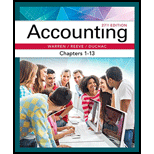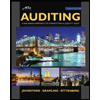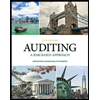
Accounting, Chapters 1-13
27th Edition
ISBN: 9781337272100
Author: Carl Warren, James M. Reeve, Jonathan Duchac
Publisher: Cengage Learning
expand_more
expand_more
format_list_bulleted
Question
Chapter 17, Problem 10DQ
To determine
Annual Report: As per Securities and Exchange Commission requirements, all the public companies are mandated to prepare the annual report. Annual report of a company contains the following information:
- Company’s financial status
- Summary about company, its industry, its brands, and its growth policies
- States the risks of the company and its competitors
Thus, annual report provides complete information about the financial position of a company. This helps the investors to make proper decisions.
To describe: Two reports provided by independent auditors in the annual report to shareholders.
Expert Solution & Answer
Want to see the full answer?
Check out a sample textbook solution
Students have asked these similar questions
I am looking for the correct answer to this general accounting problem using valid accounting standards.
What is the primary purpose of financial accounting?A) To prepare financial statements for internal use onlyB) To provide financial information to external usersC) To assist managers in decision-making within a companyD) To manage day-to-day operations of the business
Payable deferral period is
Chapter 17 Solutions
Accounting, Chapters 1-13
Ch. 17 - Prob. 1DQCh. 17 - Prob. 2DQCh. 17 - A companys current year net income (after income...Ch. 17 - How would the current and quick ratios of a...Ch. 17 - Prob. 5DQCh. 17 - What do the following data, taken from a...Ch. 17 - a. How does the return on total assets differ from...Ch. 17 - Kroger, a grocery store, recently had a price-...Ch. 17 - Prob. 9DQCh. 17 - Prob. 10DQ
Ch. 17 - Horizontal analysis The comparative temporary...Ch. 17 - Prob. 17.1BPECh. 17 - Vertical analysis Income statement information for...Ch. 17 - Vertical analysis Income statement information for...Ch. 17 - Prob. 17.3APECh. 17 - Prob. 17.3BPECh. 17 - Accounts receivable analysis A company reports the...Ch. 17 - Accounts receivable analysis A company reports the...Ch. 17 - Inventory analysis A company reports the...Ch. 17 - Inventory analysis A company reports the...Ch. 17 - Prob. 17.6APECh. 17 - Long-term solvency analysis The following...Ch. 17 - Times interest earned A company reports the...Ch. 17 - Times interest earned A company reports the...Ch. 17 - Asset turnover A company reports the following:...Ch. 17 - Asset turnover A company reports the following:...Ch. 17 - Return on total assets A company reports the...Ch. 17 - Return on total assets A company reports the...Ch. 17 - Common stockholders profitability analysis A...Ch. 17 - Common stockholders profitability analysis A...Ch. 17 - Prob. 17.11APECh. 17 - Prob. 17.11BPECh. 17 - Prob. 17.1EXCh. 17 - Prob. 17.2EXCh. 17 - Common-sized income statement Revenue and expense...Ch. 17 - Vertical analysis of balance sheet Balance sheet...Ch. 17 - Horizontal analysis of the income statement Income...Ch. 17 - Current position analysis The following data were...Ch. 17 - Prob. 17.7EXCh. 17 - Current position analysis The bond indenture for...Ch. 17 - Accounts receivable analysis The following data...Ch. 17 - Accounts receivable analysis Xavier Scores Company...Ch. 17 - Inventory analysis The following data were...Ch. 17 - Inventory analysis QT, Inc. and Elppa Computers,...Ch. 17 - Ratio of liabilities to stockholders equity and...Ch. 17 - Ratio of liabilities to stockholders equity and...Ch. 17 - Ratio of liabilities to stockholders equity and...Ch. 17 - Prob. 17.16EXCh. 17 - Profitability ratios The following selected data...Ch. 17 - Profitability ratios Ralph Lauren Corporation...Ch. 17 - Six measures of solvency or profitability The...Ch. 17 - Five measures of solvency or profitability The...Ch. 17 - Prob. 17.21EXCh. 17 - Prob. 17.22EXCh. 17 - Earnings per share, discontinued operations The...Ch. 17 - Prob. 17.24EXCh. 17 - Prob. 17.25EXCh. 17 - Prob. 17.1APRCh. 17 - Prob. 17.2APRCh. 17 - Prob. 17.3APRCh. 17 - Measures of liquidity, solvency, and profitability...Ch. 17 - Solvency and profitability trend analysis Addai...Ch. 17 - Prob. 17.1BPRCh. 17 - Prob. 17.2BPRCh. 17 - Effect of transactions on current position...Ch. 17 - Measures of liquidity, solvency and profitability...Ch. 17 - Solvency and profitability trend analysis Crosby...Ch. 17 - Financial statement analysis The financial...Ch. 17 - Prob. 17.1CPCh. 17 - Prob. 17.3CPCh. 17 - Common-sized income statements The condensed...Ch. 17 - Profitability analysis Deere Company manufactures...Ch. 17 - Comprehensive profitability and solvency analysis...
Knowledge Booster
Similar questions
- What is the amount of allocated manufacturing overhead costs for September?arrow_forwardAllowance for Doubtful Accounts has a debit balance of $1,800 at the end of the year, before adjustments. If an analysis of receivables indicates doubtful accounts of $29,500, what will be the amount of the appropriate adjusting entry? Need answerarrow_forwardAccounting answer pleasearrow_forward
- The matching principle in accounting requires that: A) Revenues and expenses be recognized in the period when cash is received or paidB) Revenues are recorded only when cash is collectedC) Expenses are matched with the revenues they help generateD) Financial statements must be prepared at the end of every quarter helparrow_forwardIf a company has total liabilities of $250,000 and total equity of $450,000, what is the total value of the company’s assets?A) $700,000B) $450,000C) $250,000D) $1,000,000arrow_forwardI am searching for the right answer to this financial accounting question using proper techniques.arrow_forward
- The matching principle in accounting requires that: A) Revenues and expenses be recognized in the period when cash is received or paidB) Revenues are recorded only when cash is collectedC) Expenses are matched with the revenues they help generateD) Financial statements must be prepared at the end of every quarterarrow_forwardPlease explain the solution to this general accounting problem with accurate principles.arrow_forwardIf a company has total liabilities of $250,000 and total equity of $450,000, what is the total value of the company’s assets?A) $700,000B) $450,000C) $250,000D) $1,000,000 Give correct anarrow_forward
arrow_back_ios
SEE MORE QUESTIONS
arrow_forward_ios
Recommended textbooks for you
 Managerial AccountingAccountingISBN:9781337912020Author:Carl Warren, Ph.d. Cma William B. TaylerPublisher:South-Western College Pub
Managerial AccountingAccountingISBN:9781337912020Author:Carl Warren, Ph.d. Cma William B. TaylerPublisher:South-Western College Pub Auditing: A Risk Based-Approach to Conducting a Q...AccountingISBN:9781305080577Author:Karla M Johnstone, Audrey A. Gramling, Larry E. RittenbergPublisher:South-Western College Pub
Auditing: A Risk Based-Approach to Conducting a Q...AccountingISBN:9781305080577Author:Karla M Johnstone, Audrey A. Gramling, Larry E. RittenbergPublisher:South-Western College Pub Auditing: A Risk Based-Approach (MindTap Course L...AccountingISBN:9781337619455Author:Karla M Johnstone, Audrey A. Gramling, Larry E. RittenbergPublisher:Cengage Learning
Auditing: A Risk Based-Approach (MindTap Course L...AccountingISBN:9781337619455Author:Karla M Johnstone, Audrey A. Gramling, Larry E. RittenbergPublisher:Cengage Learning

Managerial Accounting
Accounting
ISBN:9781337912020
Author:Carl Warren, Ph.d. Cma William B. Tayler
Publisher:South-Western College Pub


Auditing: A Risk Based-Approach to Conducting a Q...
Accounting
ISBN:9781305080577
Author:Karla M Johnstone, Audrey A. Gramling, Larry E. Rittenberg
Publisher:South-Western College Pub

Auditing: A Risk Based-Approach (MindTap Course L...
Accounting
ISBN:9781337619455
Author:Karla M Johnstone, Audrey A. Gramling, Larry E. Rittenberg
Publisher:Cengage Learning